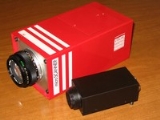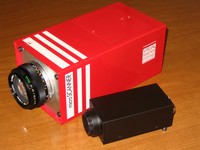
Smart camera
Encyclopedia
Although there are many definitions of smart cameras offered by the media, camera manufacturers and developers, still no binding definition exists. In a field where terms are often defined by their predominant usage, most material in this article is based on the term's most predominant usage. In the book "Smart Cameras", a smart camera is defined as a vision system which, in addition to image capture circuitry, is capable of extracting application-specific information from the captured images, along with generating event descriptions or making decisions that are used in an intelligent and automated system.
A smart camera or "intelligent camera" is a self-contained, standalone vision system with built-in image sensor in the housing of an industrial video camera. It contains all necessary communication interfaces, e.g. Ethernet, as well as industry-proof 24V I/O lines for connection to a PLC, actuators, relays or pneumatic valves. It is not necessarily larger than an industrial or surveillance camera. "Having" a capability in Machine Vision generally means a degree of development such that these capabilities are ready for use on individual applications.
This architecture has the advantage of a more compact volume compared to PC-based vision systems and often achieves lower cost, at the expense of a somewhat simpler (or missing altogether) user interface.
Although often used for simpler applications, modern smart cameras can rival PCs in terms of processing power and functionalities.
Smart cameras have been marketed since the mid 80s, but only in recent years have they reached widespread use, once technology allowed their size to be reduced while their processing power has reached several thousand MIPS (devices with 1 GHz processors and up to 8000MIPS are available as of end of 2006).
Having a dedicated processor in each unit, smart cameras are especially suited for applications where several cameras must operate independently and often asynchronously, or when distributed vision is required (multiple inspection or surveillance points along a production line or within an assembly machine).
 A smart camera usually consists of several (but not necessarily all) of the following components:
A smart camera usually consists of several (but not necessarily all) of the following components:
A video output (e.g. VGA or SVGA) may be an option for a Smart Camera.
Typical fields of application are:
Developers can purchase smart cameras and develop their own programs for special, custom made applications, or they can purchase ready made application software from the camera manufacturer or from third party sources.
Custom programs can be developed by programming in various languages (typically C or C++) or by using more intuitive, albeit somewhat less flexible, development tools where existing functionalities (often called tool or blocks) can be connected in a list (a sequence or a bidimensional flowchart) that describes the desired flow of operations without any need to write program code.
The main advantage of the visual approach Vs. programming is in a much shorter and somewhat easier development process, available also to non-programmers.
Other development tools are available with relatively few but comparatively high level functionalities, which can be configured and deployed with very limited effort.
Smart cameras running software tailored for a single specific application are often called "vision sensors."
A smart camera or "intelligent camera" is a self-contained, standalone vision system with built-in image sensor in the housing of an industrial video camera. It contains all necessary communication interfaces, e.g. Ethernet, as well as industry-proof 24V I/O lines for connection to a PLC, actuators, relays or pneumatic valves. It is not necessarily larger than an industrial or surveillance camera. "Having" a capability in Machine Vision generally means a degree of development such that these capabilities are ready for use on individual applications.
This architecture has the advantage of a more compact volume compared to PC-based vision systems and often achieves lower cost, at the expense of a somewhat simpler (or missing altogether) user interface.
Although often used for simpler applications, modern smart cameras can rival PCs in terms of processing power and functionalities.
Smart cameras have been marketed since the mid 80s, but only in recent years have they reached widespread use, once technology allowed their size to be reduced while their processing power has reached several thousand MIPS (devices with 1 GHz processors and up to 8000MIPS are available as of end of 2006).
Having a dedicated processor in each unit, smart cameras are especially suited for applications where several cameras must operate independently and often asynchronously, or when distributed vision is required (multiple inspection or surveillance points along a production line or within an assembly machine).

- Image sensor (matrix or linear, CCDCharge-coupled deviceA charge-coupled device is a device for the movement of electrical charge, usually from within the device to an area where the charge can be manipulated, for example conversion into a digital value. This is achieved by "shifting" the signals between stages within the device one at a time...
- or CMOSCMOSComplementary metal–oxide–semiconductor is a technology for constructing integrated circuits. CMOS technology is used in microprocessors, microcontrollers, static RAM, and other digital logic circuits...
) - Image digitization circuitry
- Image memory
- processorCentral processing unitThe central processing unit is the portion of a computer system that carries out the instructions of a computer program, to perform the basic arithmetical, logical, and input/output operations of the system. The CPU plays a role somewhat analogous to the brain in the computer. The term has been in...
(often a DSPDigital signal processorA digital signal processor is a specialized microprocessor with an architecture optimized for the fast operational needs of digital signal processing.-Typical characteristics:...
or suitably powerful processor) - program- and data memory (RAM, nonvolatile FLASH)
- Communication interface (RS232, EthernetEthernetEthernet is a family of computer networking technologies for local area networks commercially introduced in 1980. Standardized in IEEE 802.3, Ethernet has largely replaced competing wired LAN technologies....
) - I/OInput/outputIn computing, input/output, or I/O, refers to the communication between an information processing system , and the outside world, possibly a human, or another information processing system. Inputs are the signals or data received by the system, and outputs are the signals or data sent from it...
lines (often optoisolated) - Lens holder or built in lens (usually C, CS or M-mount)
- Built in illumination device (usually LEDLEdLEd is a TeX/LaTeX editing software working under Microsoft Windows. It is a freeware product....
) - Purpose developed real-time operating system (For example VCRT)
A video output (e.g. VGA or SVGA) may be an option for a Smart Camera.
Fields of application
Smart cameras can in general be used for the same kind of applications where more complex vision systems are used, and can additionally be applied in some applications where volume, pricing or reliability constraints forbid use of bulkier devices and PC's.Typical fields of application are:
- automated inspection for quality assurance (detection of defects, flaws, missing parts...)
- non contact measurements.
- part sorting and identification.
- code reading and verification (barcodeBarcodeA barcode is an optical machine-readable representation of data, which shows data about the object to which it attaches. Originally barcodes represented data by varying the widths and spacings of parallel lines, and may be referred to as linear or 1 dimensional . Later they evolved into rectangles,...
, Data MatrixData MatrixA Data Matrix code is a two-dimensional matrix barcode consisting of black and white "cells" or modules arranged in either a square or rectangular pattern. The information to be encoded can be text or raw data. Usual data size is from a few bytes up to 1556 bytes. The length of the encoded data...
, alphanumericOptical character recognitionOptical character recognition, usually abbreviated to OCR, is the mechanical or electronic translation of scanned images of handwritten, typewritten or printed text into machine-encoded text. It is widely used to convert books and documents into electronic files, to computerize a record-keeping...
etc.) - web inspection (inspection of continuously flowing materials such as coils, tubes, wires, extruded plastic) for defect detection and dimensional gauging.
- detection of position and rotation of parts for robotRobotA robot is a mechanical or virtual intelligent agent that can perform tasks automatically or with guidance, typically by remote control. In practice a robot is usually an electro-mechanical machine that is guided by computer and electronic programming. Robots can be autonomous, semi-autonomous or...
guidance and automated picking - unattended surveillance (detection of intruders, fire or smoke detection)
- biometricBiometricsBiometrics As Jain & Ross point out, "the term biometric authentication is perhaps more appropriate than biometrics since the latter has been historically used in the field of statistics to refer to the analysis of biological data [36]" . consists of methods...
recognition and access control (faceFacial recognition systemA facial recognition system is a computer application for automatically identifying or verifying a person from a digital image or a video frame from a video source...
, fingerprintFingerprintA fingerprint in its narrow sense is an impression left by the friction ridges of a human finger. In a wider use of the term, fingerprints are the traces of an impression from the friction ridges of any part of a human hand. A print from the foot can also leave an impression of friction ridges...
, iris recognition) - visual sensor networkVisual sensor networkA visual sensor network is a network of spatially distributed smart camera devices capable of processing and fusing images of a scene from a variety of viewpoints into some form more useful than the individual images. A visual sensor network may be a type of wireless sensor network, and much of the...
s - robot guidance
- nearly any machine vision application
Developers can purchase smart cameras and develop their own programs for special, custom made applications, or they can purchase ready made application software from the camera manufacturer or from third party sources.
Custom programs can be developed by programming in various languages (typically C or C++) or by using more intuitive, albeit somewhat less flexible, development tools where existing functionalities (often called tool or blocks) can be connected in a list (a sequence or a bidimensional flowchart) that describes the desired flow of operations without any need to write program code.
The main advantage of the visual approach Vs. programming is in a much shorter and somewhat easier development process, available also to non-programmers.
Other development tools are available with relatively few but comparatively high level functionalities, which can be configured and deployed with very limited effort.
Smart cameras running software tailored for a single specific application are often called "vision sensors."

